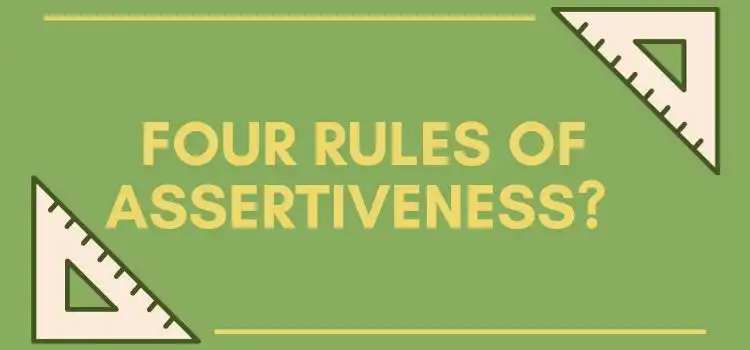Nowadays effective communication is the golden ticket to success and in this case, assertiveness stands as a mighty skill. But, here’s the kicker — it’s often misunderstood, mistaken for aggression, or timidly underutilized. So, what are the four rules of assertiveness that can help you navigate the delicate balance between being a doormat and a steamroller?
Buckle up, because we’re about to explore the field of assertiveness and equip you with the tools to assert yourself confidently and respectfully. Therefore, without wasting much time, let’s get into them straightforwardly.

Four Rules Unveiled
So, what are the four significant rules that can ensure proper assertiveness? Assertiveness, often misconstrued as mere self-confidence, encompasses a set of distinct principles. These four fundamental rules serve as the bedrock of assertive communication –
Rule 1: Express Your Needs and Desires
Imagine — you’re at a restaurant, and the waiter serves you the wrong dish. The passive person might reluctantly accept it, the aggressive one would snap, but the assertive individual would calmly state their preference. This is the essence of rule one – expressing your needs and desires. It’s about understanding that your opinions and wants are valid. Whether in personal relationships or professional settings, assertiveness begins by speaking up.
Expressing your needs isn’t a one-size-fits-all approach. It’s more like a personalized recipe. You blend in a dash of clarity, a pinch of empathy, and a sprinkle of confidence. And voilà, you’ve got a balanced dish of assertiveness!
Rule 2: Respect the Needs and Desires of Others
Assertiveness isn’t a solo act; it’s a duet. Rule two highlights the importance of respecting the needs and desires of others. It’s about recognizing that your assertiveness shouldn’t trample on someone else’s rights. Think of it as a dance – you take your steps, but you’re mindful of your partner’s moves too.
This rule involves active listening, empathy, and a genuine desire to find mutually beneficial solutions. It’s the art of negotiation without the battlefield. Remember, assertiveness doesn’t mean bulldozing; it’s about building bridges.
Rule 3: Be Open to Feedback and Criticism
Criticism – the word that sends shivers down many spines. But, it’s an integral part of growth. Rule three urges you to embrace feedback and criticism. When you assert yourself, not everyone will applaud. Some might offer critique, and that’s okay.
Being open to feedback doesn’t mean you have to accept every comment blindly. It means listening, evaluating, and choosing whether it serves your growth or not. Constructive criticism is like a compass guiding you toward improvement. Assertiveness, after all, is a journey of continuous refinement.
Rule 4: Use ‘I’ Statements and Maintain Calmness
The final rule of assertiveness is a golden nugget – use ‘I’ statements and maintain calmness. Instead of saying, “You’re always late, and it’s infuriating!” try “I feel frustrated when plans are delayed.” See the difference? ‘I’ statements express your feelings without accusing or blaming.
Calmness is your trusty companion on this assertiveness journey. It’s the shield that deflects aggression and ensures your message is heard. When you keep your cool, you increase the chances of a productive conversation.
Summarization
In a world filled with varying communication styles, mastering assertiveness is like having a superpower. It allows you to express yourself authentically, consider others’ perspectives, grow through feedback, and communicate effectively. Remember, assertiveness isn’t about perfection; it’s about progress.
End Note
As we wrap up our exploration of the four rules of assertiveness, remember that it’s a skill you can cultivate and refine over time. Express your needs and desires, but do so respectfully. Embrace feedback and criticism as opportunities for growth. Use “I” statements and maintain calmness in your interactions. The world is your stage, and assertiveness is your script to navigate it with confidence and grace. So, go ahead, embrace your assertive self, and let your voice be heard. If you have any more questions or need further guidance on assertiveness, don’t hesitate to leave a comment below. Thank you for joining us on this assertiveness journey, and here’s to your confident communication!